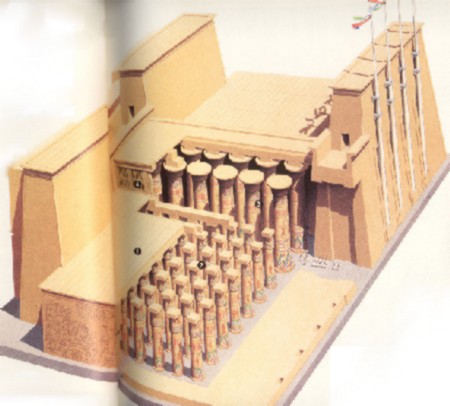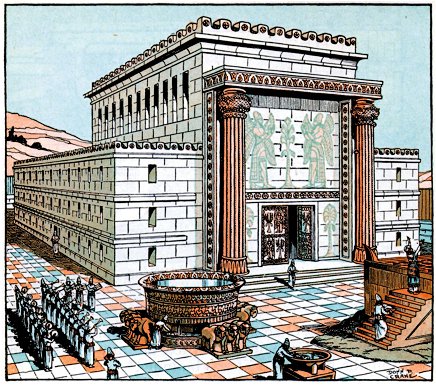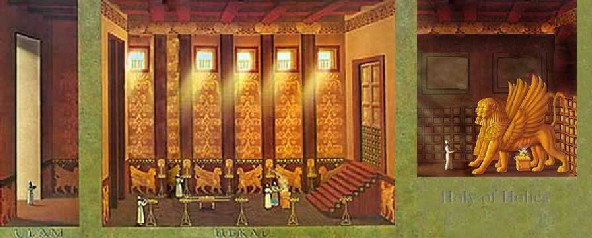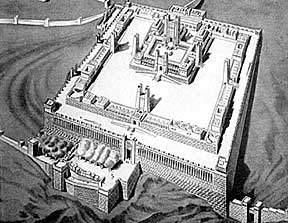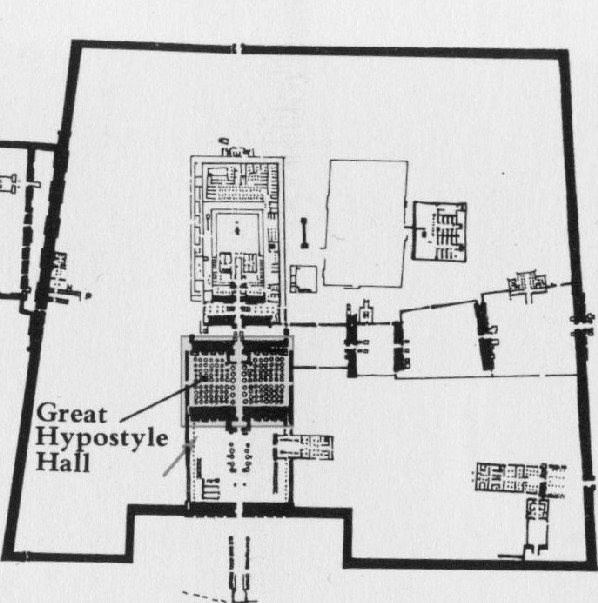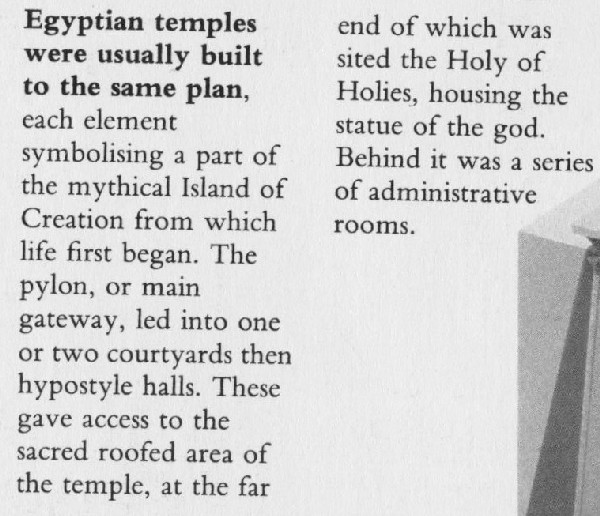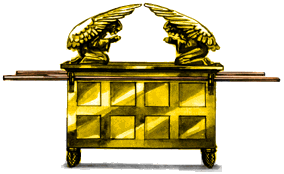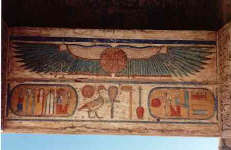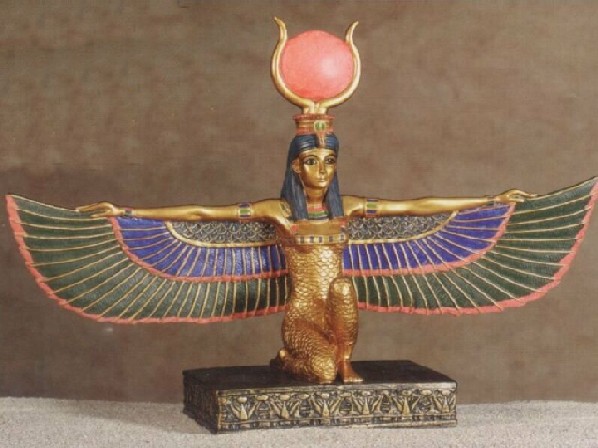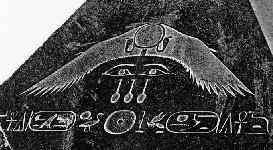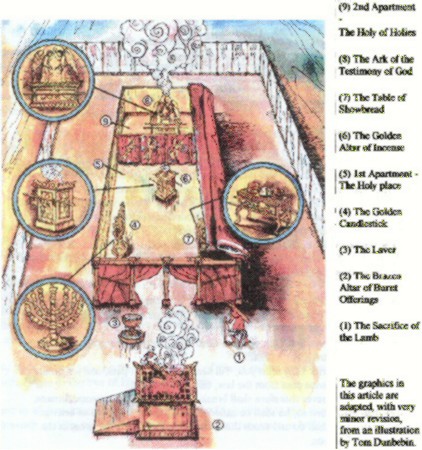GODS OF ANCIENT EGYPT
![]()
I've been
watching and recording the series on the "gods of Ancient Egypt" and
it is very interesting. It shows where the "trinity" doctrine started
and it wasn't with Christians. Yet traditional Christians will call you a
heretic if you don't believe in the trinity as they do.
Here are
some notes that I made while watching the Egyptian Series, I may add more later: (Also some of it is from notes that I made in my
journal, years ago, when I was studying this subject.) There are also a few
links at the bottom for anyone interested in further study.
![]()
There are
many parallels between Egyptian and "traditional Christian" doctrines
and beliefs. The Egyptian religion goes back over 5000 years ago and their
culture lasted for 3000 years. In fact, what’s left of
Egyptian religion are mostly religious relics. They had many gods but
"three" main ones, which made up their trinity. Isis
- the mother, Osirus - the son and Seth - the father.
They had
temples MUCH like the Hebrew temples as well as priests, animal sacrifice and
etc.. The temple at Karnak
is amazingly like the Hebrew temples. It had an outer court, inner court and
the hidden "holy place" where the spirit of the god dwelled.
The
Egyptians, not the Hebrews, were the first to believe in the "one true
god" whose name varied (like Re, Ra or Ray) and eventually became Amon. They believed that god was one god in many forms. Akhenaten was a pharaoh who was considered the heretic king
because he banned the worship of all deities except the "one true
god", Amon. He kept only the "elite"
priesthood to be intermediaries between the people and the god. Sounds just
like the Hebrew religion doesn't it? (As well as the GAC
religion that I was associated with.) We have to remember that Moses was
born and raised in Egypt and was taught the Egyptian religions. They even
carried their gods around in boxes (arks) like the Ark of the Covenant. They
had the knowledge to make these boxes or "arks" so that they were
like batteries and if you touched them, they could shock you. In fact the word
ark in this form: "arc" can mean "electricity. Moses had the
knowledge to make these arks. Sometimes they were in the form of boats that
they carried about on their shoulders and the god lived in them.
arc (ärk)
n. 1. Something shaped like a curve or an arch. (like
a boat or Noah's ark) 2. Mathematics. A segment of a circle.
3. Electricity. A luminous discharge of current that is
formed when a strong current jumps a gap in a circuit or between two
electrodes.
1 Chron.
15:15 - And the children of the Levites bare the ark of God upon their
shoulders with the staves thereon, as Moses commanded according to the word of
the LORD.
Amos 5:26 -
But ye have borne the tabernacle of your Moloch and Chiun
your images, the star of your god, which ye made to yourselves.
1 Chron.
13:9-10 - And when they came unto the threshingfloor
of Chidon, Uzza
put forth his hand to hold the ark; for the oxen stumbled. [10] And the anger
of the LORD was kindled against Uzza, and he smote
him, because he put his hand to the ark: and there he died before God.
May I ask a
question here? What kind of God would smite a man dead because He was so angry,
even though the man was only trying to protect the ark because the oxen
stumbled? Not the one I know. It seems to me that Uzza
put forth his hand and touched the ark and was electrocuted. That’s the only
thing that really makes sense in the light of knowing that it is not in God’s
nature to simply strike someone dead because they were trying to protect
something that belonged to god.
Acts 7:40-50
- Saying unto Aaron, Make us gods to go before us: for as for this Moses, which brought us out of the land of Egypt, we wot not what is become of him. [41] And they made a calf in
those days, and offered sacrifice unto the idol, and rejoiced in the works of
their own hands. [42] Then God turned, and gave them up to worship the host of
heaven; as it is written in the book of the prophets, O ye house of Israel,
have ye offered to me slain beasts and sacrifices by the space of forty years
in the wilderness? [43] Yea, ye took up the tabernacle of Moloch, and the
star of your god Remphan, figures which ye made to
worship them: and I will carry you away beyond Babylon. [44] Our fathers
had the tabernacle of witness in the wilderness, as he had appointed, speaking
unto Moses, that he should make it according to the fashion that he had seen.
[45] Which also our fathers that came after brought in with Jesus into the
possession of the Gentiles, whom God drave out before
the face of our fathers, unto the days of David; [46] Who found favour before God, and desired to find a tabernacle for
the God of Jacob. [47] But Solomon built him an house.
[48] Howbeit the most High dwelleth NOT in temples
made with hands; as saith the prophet, [49]
Heaven is my throne, and earth is my footstool: what house will ye build me?
saith the Lord: or what is
the place of my rest? [50] Hath not my hand made all these things?
I know that
Paul and others used the scenario from the Hebrews to point the way to Christ.
They built a bridge, as it were, so that the people could have some kind of
understanding of what the true temple was. WE ARE THAT TEMPLE. The religion
that the Hebrews practiced came right out of Egypt and Babylon, even the
practice of circumcision.
Another
example is this from the American People Encyclopedia:
Molech or Moloch – Tribal
god of fire who was worshipped by the Ammonites. Also known as Milcom (I Kings 11: 5, 33) and Malcom
(Jer 49:1-3; Zeph 1:5) The
Israelites, through Moses, were expressly forbidden to practice what appears to
be a distinguishing feature of his worship, the sacrifice of children as burnt
offerings. (Lev 18:2) Moleck had a place of worship
in the valley of Hinnom (Jer
32:35) Both SOLOMON AND AHAZ are said to have introduced the worship of Molech among the Israelites.
So again I
ask, WHY do we really believe that the true God told
Abraham to sacrifice his son by slitting his throat, draining his blood and
burning him at the stake? I know all the typical reasons that people give for
this but it still doesn’t make sense to me. It used to but I just cannot
believe that God has to go to these kinds of extremes, against His own
commandments to prove that someone has faith. I believe that Abraham may have
picked up this practice from the Ammonites.
The
Egyptians believed in “Theogamy” which is the process
by which the supreme god of the time took on the form of the reigning king or
pharaoh in order to beget a child upon the queen, the child being destined to
become the King of Egypt, the offspring of both earthly and heavenly father.
They also
believed in polytheistic or many gods and at one point, monotheistic or ONE
god.
From The
Gods of Ancient Egypt, page 59:
RE (God) –
self engendered Eternal Spirit who first appeared on the waters of the Nun as a
beautiful child floating on a great blue Lotus. Having
created himself by means of magic, turned his attention to the creation of the
world. He made the 4 winds, the inundation waters, from god’s sweat,
from tears, he created mankind. The magic he used for his creation was the
WORD. He spoke the WORD and by speaking the names of things, he created them.
The method
of creating things by the WORD or name was used by the Great God of the
Babylonians and the God of the Hebrews.
John 1:1-3 -
In the beginning was the Word, and the Word was with God, and the Word was God.
[2] The same was in the beginning with God. [3] All things were made by him;
and without him was not any thing made that was made.
Another
deity that was worshipped by the Babylonians was TAMMUZ. This is from the Bible
Dictionary and the American Peoples Encyclopedia:
Ezekiel 8:14
- Then he brought me to the door of the gate of the LORD'S house which was
toward the north; and, behold, there sat women weeping for Tammuz.
TAMMUZ – A deity
worshipped by Babylonians, Assyrians and Phoenicians. It is also the fourth
month of the Jewish sacred year.
Thammuz of Tammuz – Dry
season. Mythological god of vegetation whose death and
subsequent resurrection represent the seasonal cycles of growth and decay and
new growth. The name TAMMUZ derives from the Sumerian Dumuzi, which has been variously translated as:
The son who
is arisen and goeth forth,
The faithful
son,
The
resurrected child,
And so on……
Tammuz has
been characterized as a sun god, nature god, fertility god and even as the
“Supreme – god – of – all.” In regard to the last of these characterizations,
it may be noted that the Hebrew word, ADONAI (Lord) is thought by some to have
been derived from the name of the Syrian Greek deity, ADONIS, whose place in
Syrian Greek mythology was analogues to that of TAMMUZ in the mythologies of
which he was a major figure.
Other very
likely analogues to Tammuz are the Egyptian “Osirus”
and the Phrygian, “Attis.” In addition, various
aspects of the Tammuz myth were the synchronized into the mythologies of
numerous cultures, including the Hebrew. Tammuz spent half the year in the
underworld and the other half in the upper world. Thus was established the
ancients held, nature’s habit of annual withdrawal and return, growth and
decay, “death and resurrection.”
![]()
Explore more
than 3.000 years of Ancient Egyptian history, from the end of prehistory
at around 3.000 BC to the closing of the last Egyptian temple in 535/537 A.D. A time-line helps you navigate through
history and discover the formidable Pharaohs of Ancient Egypt.
Some links:
http://www.ancientegypt.co.uk/gods/explore/main.html
http://www.guardians.net/egypt/
![]()
Temple of Karnack
The temple
of Karnak was known as Ipet-isut
(Most select of places) by the ancient Egyptians. It is a city of temples built
over 2000 years and dedicated to the Theben triad of Amon, Mut and Khonsu.
This
derelict place is still capable of overshadowing many of the wonders of the
modern world and in its day must have been awe inspiring.
For the
largely uneducated ancient Egyptian population this could only have been the
place of the gods. It is the mother of all religious buildings, the largest
ever made and a place of pilgrimage for nearly 4,000 years. Although
today’s pilgrims are mainly tourists. It covers about 200 acres 1.5km by
0.8km The area of the sacred enclosure of Amon alone is 61 acres and would hold ten average European cathedrals.The great temple at the heart of Karnak is so big, St Peter's, Milan and Notre Dame
Cathedrals could be lost within its walls. The Hypostyle hall at 54,000 square
feet with its 134 columns is still the largest room of any religious building
in the world. In addition to the main sanctuary there are several smaller
temples and a vast sacred lake.
The photos
are here.... http://www.eyelid.co.uk/karnak1.htm
![]()
TEMPLE AT KARNAK (EGYPT)
|
||
SOLOMON’S TEMPLE
|
INSIDE SOLOMON’S TEMPLE
SIDE VIEW
|
|
|
SOLOMON’S TEMPLE
BIRDSEYE VIEW
|
||
|
TEMPLE AT KARNAK
BIRDSEYE VIEW (OUTLINE)
|
||
|
|
||
|
|
||
|
SIMILARITIES: Both
had three parts. Both had a Holy of Holies where the spirit of the God dwelt.
Both sacrificed animals to this god. Only the priests could go between the
god and the common people. Another common thread is the wings of the cherubim
over the ark. The goddess Isis also had wings. Psalm 91:4 - He shall cover thee
with his feathers, and under his wings shalt thou
trust: his truth shall be thy shield and buckler. |
||
|
Hebrew Cherubim
with wings |
Egyptian winged sun
disk or god |
|
|
Goddess Isis |
Another view -
Winged sun disk |
|
TABERNACLE IN THE WILDERNESS
|
||
